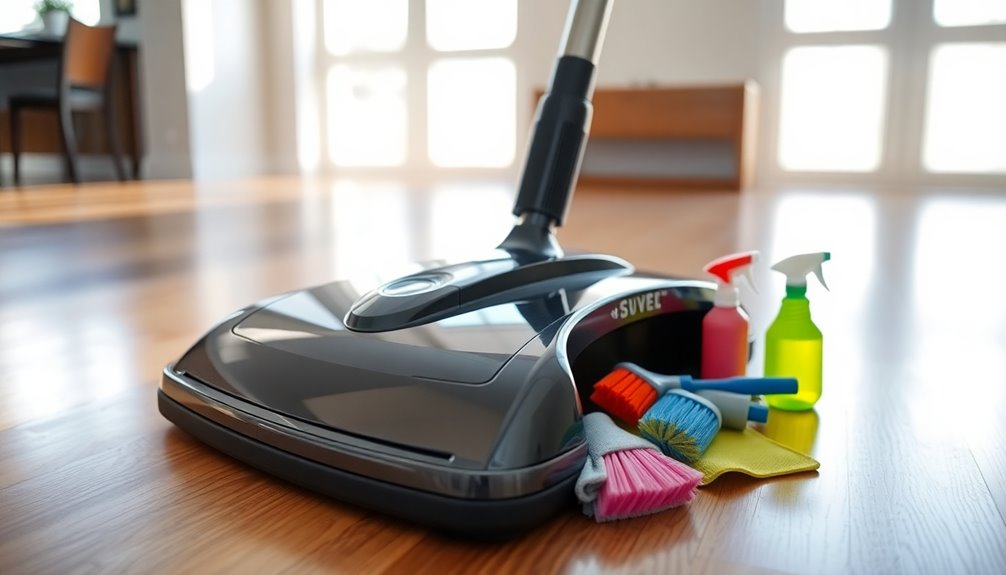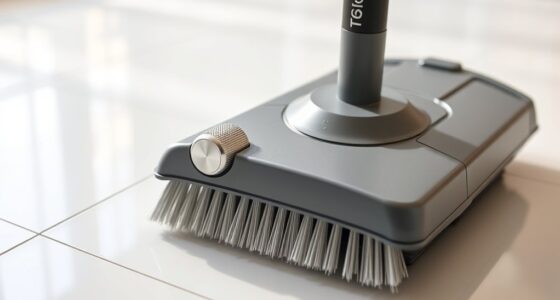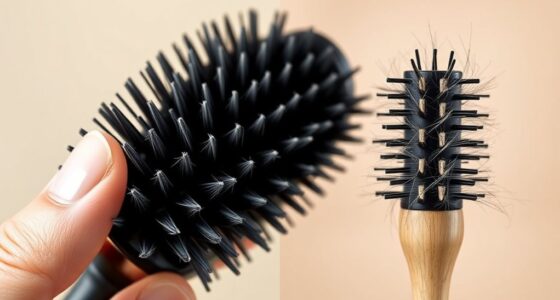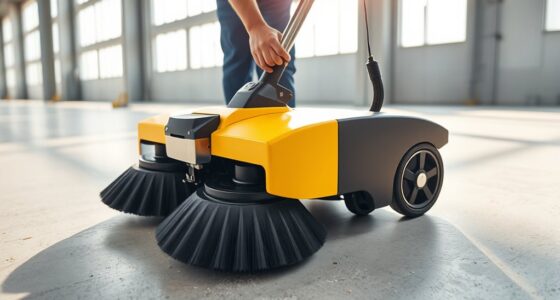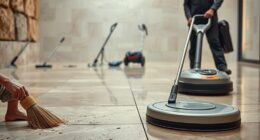To avoid a cleaning crisis with your floor sweeper, start by checking power supply issues like outlets and cords. Inspect brushes for debris and ensure they're properly aligned. Don't overlook suction issues; clear blockages and replace worn filters. Routine maintenance, including cleaning components and lubricating parts, is essential for peak performance. With these tips, you can keep your sweeper running smoothly. Keep going to uncover more vital strategies for trouble-free cleaning.
Key Takeaways
- Regularly inspect power supplies, ensuring outlets work and cords are undamaged for uninterrupted operation of your floor sweeper.
- Clear debris from brushes and check drive belts to maintain optimal sweeping performance and prevent brush-related problems.
- Ensure suction mechanisms are free of blockages and filters are clean to guarantee effective debris collection.
- Conduct routine maintenance checks, lubricate moving parts, and replace worn components to extend the lifespan of your sweeper.
- Train operators on proper usage and maintenance, and document inspections to proactively identify and resolve potential issues.
Identifying Power Supply Issues
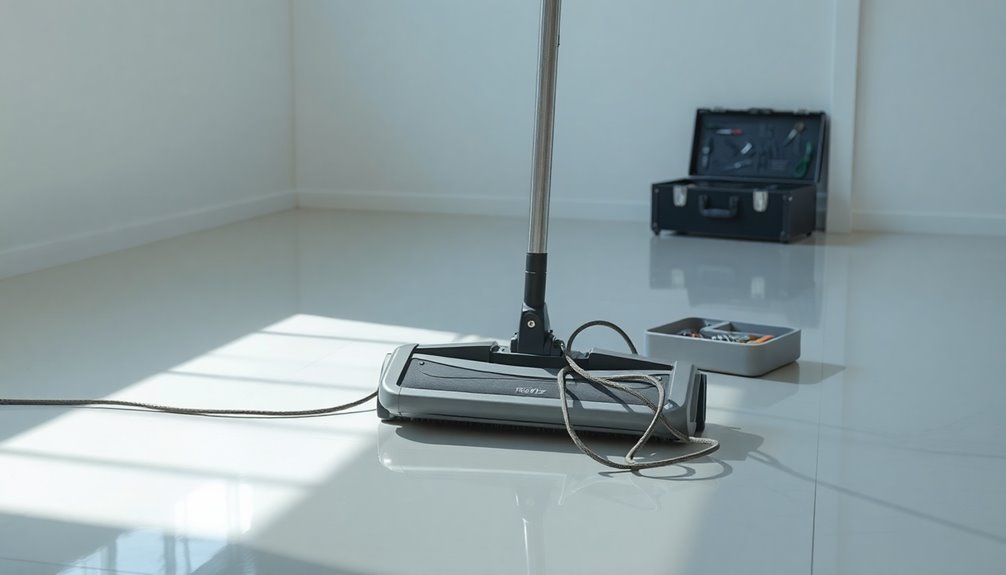
Have you ever found yourself struggling to get your floor sweeper to power on? First, check if it's plugged into a functioning outlet.
If you're using a corded model, inspect the power cord for frays or bent prongs. For battery-powered sweepers, ensure the batteries are fully charged and connections are secure. Allow enough charging time and regularly check the battery's health. Additionally, make sure that the sweeper has not been overheated due to extended use, as this could prevent it from turning on.
It's also crucial to confirm that the correct power source is selected and that the sweeper hasn't overheated. If you're in a commercial setting, check for tripped circuit breakers.
Troubleshooting Brush-Related Problems
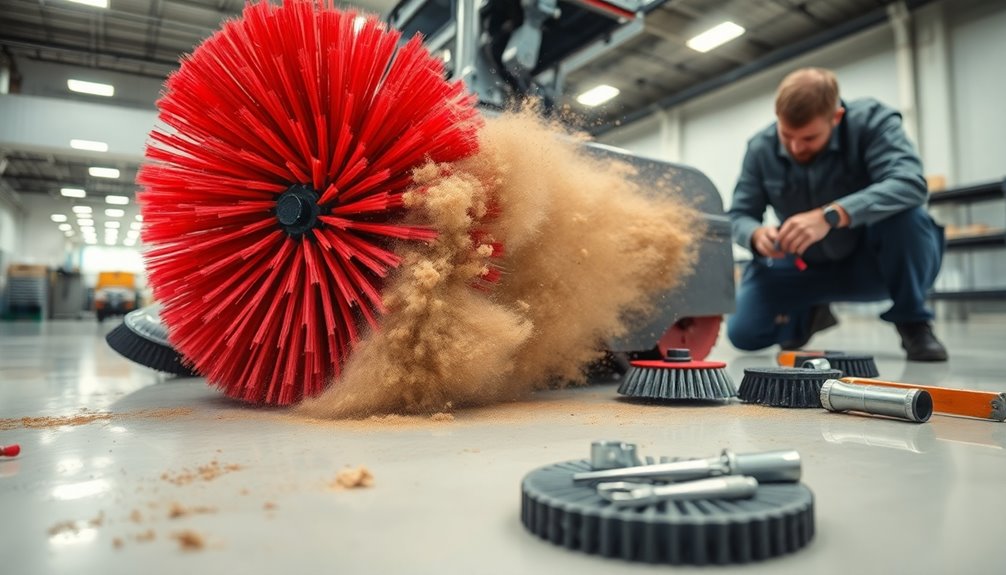
Once you've ensured your floor sweeper has power, the next step is to address any brush-related problems that might be hindering its performance.
Check for debris buildup in the main brush, as this can restrict movement. Ensure the belt isn't too tight or loose, as this affects rotation. Inspect for worn brushes that may need replacing and confirm you're using the correct brush type for your floor. Inspect the drive belt to ensure it is free from wear or damage, as this can also affect the brush's operation.
Misalignment can lead to uneven sweeping, so adjust accordingly. For side brushes, ensure they're not lying flat and check for material obstructions.
Regular inspections and maintenance are key to keeping your brushes in top shape, so don't skip these essential steps!
Resolving Suction and Debris Collection Issues
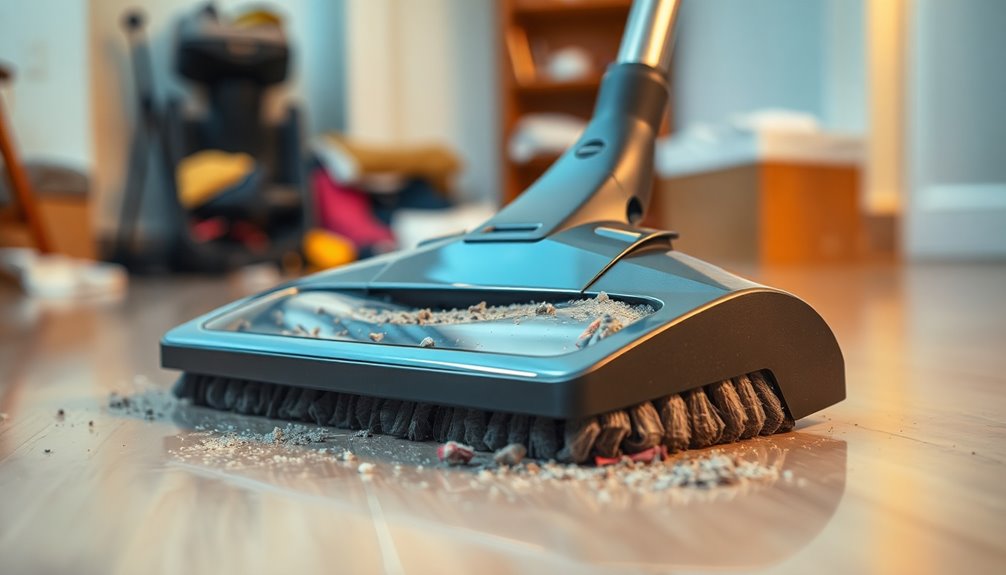
To keep your floor sweeper running efficiently, addressing suction and debris collection issues is crucial.
Start by checking for blockages in the suction hose and flaps, as these can impede airflow. Inspect the flaps for wear and replace them if needed. Don't forget to clean or replace filters regularly to maintain suction. Regularly checking for blocked solution filters can also prevent water flow restrictions that impact cleaning performance.
Ensure your sweeper is compatible with the surface type; otherwise, suction issues may arise. For debris collection, confirm you're using the correct brush type and regularly inspect for wear. Ensure side brushes direct debris to the main brush effectively.
Lastly, empty the waste hopper often to avoid overflow and consider the size of debris your sweeper can handle. Regular maintenance is key to preventing these problems.
Maintaining Your Floor Sweeper

While keeping your floor sweeper in top shape may seem daunting, regular maintenance is essential for optimal performance. Start with routine visual checks for signs of damage and ensure all parts are securely fastened. Clear any debris that could obstruct operation, and check the battery's condition for peak performance. Don't forget to verify the status of filters—they should be clean and functioning well. Regularly conduct visual inspections to catch minor issues before they escalate. Additionally, maintaining the clean fuel injectors in your equipment can significantly enhance its overall efficiency.
Maintain both the exterior and interior by cleaning components like brushes and suction mechanisms. Lubricate moving parts as per the manufacturer's guidelines and replace worn-out parts promptly. Regular pre-use checks can also help ensure your sweeper is ready to go. By following these steps, you'll prolong your sweeper's life and enhance its efficiency.
Preventing Future Cleaning Crises
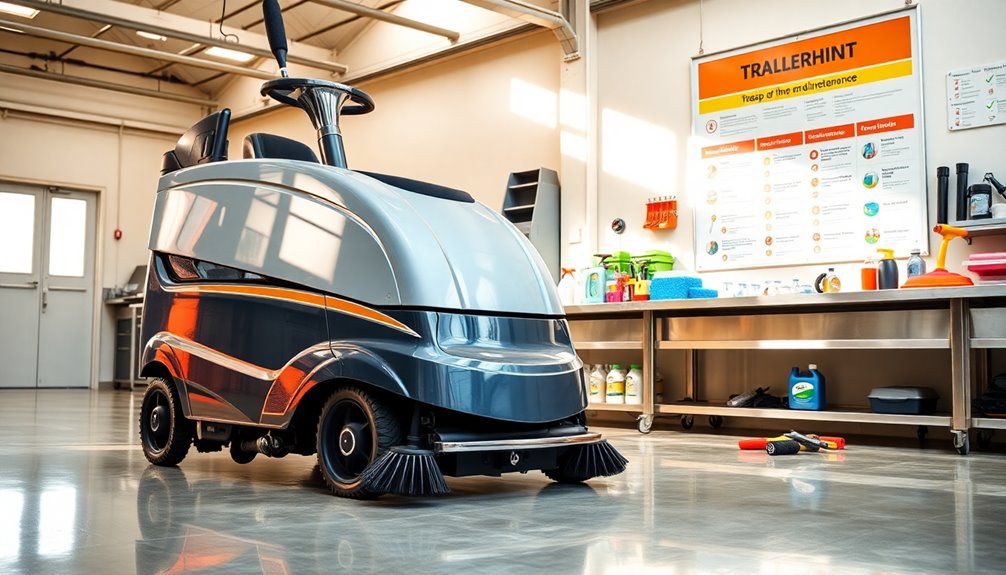
Preventing future cleaning crises starts with proactive measures that keep your floor sweeper in top condition.
Regular inspections allow you to spot potential issues before they escalate, while proper training ensures operators know how to use and maintain the equipment correctly. Ensuring that you perform regular inspections is essential for identifying any wear and tear before it turns into a major problem.
Scheduling maintenance is key; it keeps your sweeper running optimally. Additionally, steer clear of environments with debris that could damage the machine, like ropes or strings. Documenting maintenance activities in a log helps you track what's been done and what needs attention.
By adopting these practices, you'll minimize the risk of unexpected breakdowns and ensure your sweeper performs efficiently when you need it most. Your proactive approach can make a significant difference in preventing cleaning crises.
When to Seek Professional Assistance
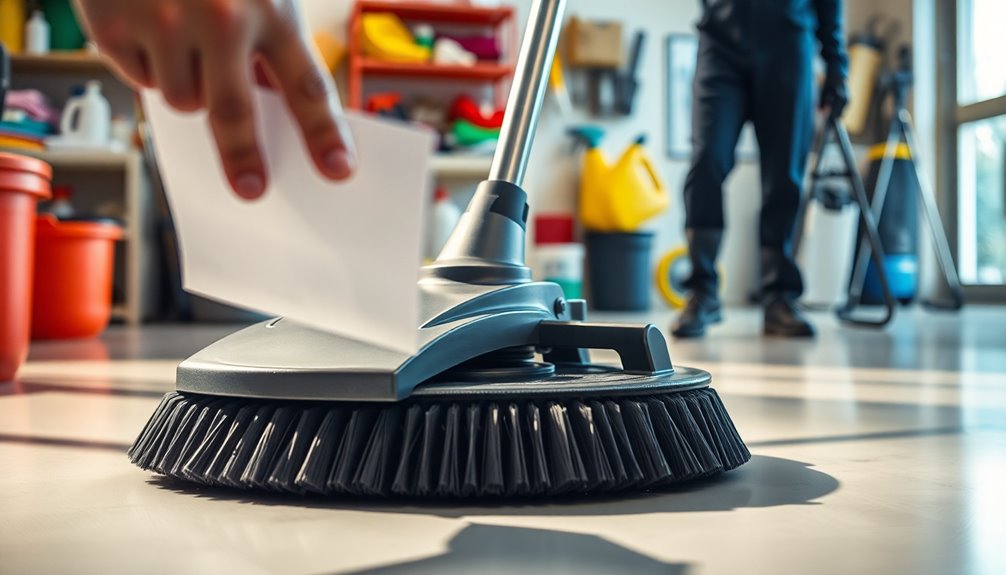
Knowing when to seek professional assistance can save you time, money, and headaches. If you notice malfunctioning motors or complex electrical issues, it's best to call an expert. Regular maintenance tasks can help prevent many issues, but advanced troubleshooting beyond basic steps often requires specialized knowledge, so don't hesitate to reach out. If your equipment is under warranty, always consult authorized technicians to avoid voiding it.
Safety concerns also merit professional help—never risk an accident. Additionally, if you need to replace specialized parts or tackle complex system failures, experts have the necessary tools and experience. Finally, consider a cost-benefit analysis; investing in professional assistance can be more efficient than costly in-house repairs. Prioritize effective resource allocation to maintain your floor sweepers' performance. Remember, when dealing with emotional support during challenging times, seeking help can lead to better outcomes for everyone involved.
Frequently Asked Questions
How Often Should I Replace the Brushes on My Floor Sweeper?
You should replace the brushes on your floor sweeper every 1.5 years under normal conditions.
However, if you use it in high-intensity environments, consider replacing them every 2-3 months.
Keep an eye on the bristles—when they're worn down significantly or if you notice reduced cleaning efficiency, it's time for a change.
Regular inspections will help you catch wear early and maintain optimal performance for your sweeper.
What Type of Battery Is Recommended for My Floor Sweeper Model?
As the saying goes, "you get what you pay for."
When choosing a battery for your floor sweeper, consider your usage patterns and budget.
Lithium-ion batteries are often recommended due to their lightweight, fast charging, and eco-friendly benefits.
If you're looking for something more budget-friendly, lead-acid batteries are a solid option, though they require more maintenance.
Ensure the battery you choose meets your sweeper's power needs for optimal performance.
Can I Use My Floor Sweeper on Outdoor Surfaces?
Yes, you can use your floor sweeper on outdoor surfaces, but it depends on the model.
Many sweepers designed for indoor use may struggle with larger debris and uneven ground. If your sweeper is built for outdoor tasks, ensure it has durable features, a wide cleaning path, and adjustable brushes.
Regular maintenance is key to keeping it in top shape, especially when faced with harsh weather conditions and heavy debris.
Is It Safe to Operate a Floor Sweeper in Wet Conditions?
Operating a floor sweeper in wet conditions is like trying to navigate a slippery slope on roller skates—risky at best.
You can increase slip hazards, damage the equipment, and reduce efficiency. If you must use it, ensure you're wearing non-slip shoes and inspect the sweeper beforehand.
Always post warning signs and be ready to handle potential accidents. Safety first, so you don't find yourself in a slippery situation!
What Common Mistakes Should I Avoid When Using a Floor Sweeper?
When using a floor sweeper, avoid common mistakes like neglecting to remove large debris first, which can hinder efficiency.
Make sure you regularly maintain and clean the sweeper, including brushes and filters.
Always follow safety precautions and provide proper training for operators.
Don't ignore the manufacturer's guidelines, as they're crucial for performance.
Lastly, ensure you're using the right model for your specific floor type to maximize effectiveness.
Conclusion
By keeping these troubleshooting tips in mind, you won't just survive a cleaning crisis; you'll dance through it like a pro. When power issues dim your spark, or brushes falter like a tired dancer, you'll know how to bring the rhythm back. Regular maintenance is your backstage pass to smooth performances, while knowing when to call in the pros ensures your floor sweeper remains a trusty partner. So, take charge and let your cleaning routine shine bright!
